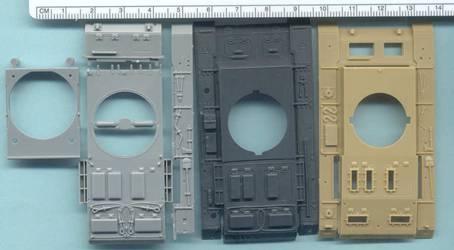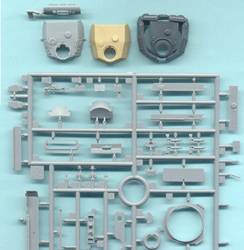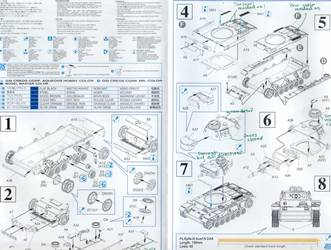| This model is
the last significant version of the German Panzerkampfwagen III tank
and represents a change in role from a battle tank with a high velocity
37-mm or 50-mm gun to a support panzer with a low velocity 75-mm gun.
This kit is basically the same as the new DML Pz III L kit # 7385
except for the different main weapon, so the comments below on the
parts should also count for both kits.

The Box Art
The typically very nice DML box art painting depicts a Pz III in tan
coloring accompanied by several Pz.Kpfw.VI Tiger I tanks. One of the
Pz III N’s initial roles was to support the Tiger Battalions.
Let’s see what the vehicle looks like, so we can later see if
this is what is in the box. The radio antenna on the starboard side
is raised and sandbag supplementary armor is piled around the front
and sides. On the bow are two lengths of spare track. Between the
sandbags we see the bow machine gun peaking out on the left and the
driver’s direct vision visor on the left.
Up on the turret we see a commander
figure, a helmet hanging from the triple smoke grenade dischargers,
and the short 75-mm gun and the coaxial machine gun. The wheels we
have seen before on the DML Sturmgeschütz III kits.
The Pz III is set in Tunisia and painted
in Afrika tan. There are markings for two Panzer III’s in North
Africa.
The Parts Diagram
There are about 89 light-gray injection molded parts, 6 etched brass
parts and two DS plastic band tracks. The parts diagram below the
box art is typical of DML kits and shows this kit’s four sprues
and separate upper and lower hull parts. Unlike many DML kits there
are not a lot of extra, unused parts we can scrounge for use with
other models.
The lower hull is slide molded, so
has good detail without having to be made in three parts like the
Revell and ESCI Pz III kit lower hulls. Like the other kits, the torsion
bar arms are molded in-place and cannot articulate. There are no sandbags
for laying on the bow but these can be made with some epoxy putty.
Two small photo etched frets,
MA and MB, supply air intake screens and a plate over the front appliqué
armor.

Here is a comparison of the multiple-part, light gray Dragon Panzer
III hull parts at far left, the gray plastic ESCI/Italeri Pz III upper
hull in the center, and the amber plastic Revell AG Pz III hull at
right. I imagine DML’s goal with producing the upper hull in
about nine parts where the others do the same thing in one or two
parts is to achieve greater detail? Or perhaps options to produce
multiple variants with modular parts?
On the fenders we see that a lot of
the tools are molded into the fenders like what Revell and
ESCI did; though done very well, this is very disappointing for me.
On the engine deck the towing cables are also molded onto the deck
like with the old ESCI kit. What is most disappointing for me is that
the six rectangular engine vents are also molded down onto the engine
deck like the old ESCI kit. Unforgivable for a company like Dragon!
DML did not do this when they produced their StuG III kits, so why
did they do it with their 1/72 Pz III which has basically the same
engine deck? To add salt to the wound, the vents are so low that we
cannot cut a reasonable groove along the bottom to simulate the vent
opening like I have done with the ESCI kit. Come on Dragon, this would
have meant just six more parts, just six simple rectangles in a kit
that does not have a lot of parts to begin with! My assessment is
that this was poor judgment for the designers and will keep me from
purchasing any more of these Pz III kits from DML. I guess we could
cover the engine deck with tank riding infantry or stowage?
The lower hull is one-piece slide molded
with the sides and torsion bars and roadwheel axles molded in, similar
to their StuG III kit.

Here, on sprue-A ,we find a superbly rendered turret bin at upper
left. At upper right are the hull superstructure sides with nice visors;
and is that interior visor detail on part A14 even though there is
no open hatch to be able to see it? Below the superstructure sides
are four separate shock absorbers that ESCI and Revell mold into their
Pz III hull sides. The driver’s plate, rear plate, and mantlet
are superbly done.
The turret cupola is well done but
unfortunately all the visors are molded closed so if displayed in
combat the commander cannot see anything! This is a problem with ESCI
and Revell Pz III and Pz IV cupolas also. The screw detail on the
turret roof looks good. Like the ESCI and Revell turrets, the grab
handle above the side hatches is molded onto the roof: disappointing.
A small issue is that the six turret
smoke grenade dischargers at center left (parts A22 & A23) are
molded pointing in one direction; all six actually pointed in slightly
different directions in an arc across the front of the turret. The
two mufflers are particularly well done. There is one spare track
holder included (part A38) on the bow of the panzer but no spare track
as portrayed in the box art.
There are no crew figures included,
Of particular interest are two small
hatches at upper left. These are lower side hull escape hatches for
an early Pz III variant. I suspect and hope that a 37-mm or short
50-mm armed Pz III may be in the plans.
(Ed. note: these hatches might be used on this kit as some Ausf.
N were built on early Ausf. L chassis.)
While the ESCI Pz III Ausf. N and Ausf.
M, and the Revell Pz III Ausf. M come with Schürzen side skirts
and brackets, the Dragon kit does not.

This scan compares the gray DML wheels with the Revell wheels below.
Both are done very well but I like DML’s just a little better.
The return rollers are slide molded as one unit. Based on the sprue-D
tab at the left that states “1/72 StuG III” we see that
this DML sprue is the same as that in their Sturmgeschütz III
kit.

DML’s assembly instructions
are their standard exploded view style with eight clear steps. Something
I don’t recall from DML’s earlier instructions is the
notes on handling and stretching the DS plastic track material located
at lower right of this scan. Missing from the DML model is the deep
fording muffler that is available in the ESCI and the Revell AG Pz
III kits. (Ed. note: this muffler would be appropriate for Ausf.
N built on Ausf. M chassis.)
The directions show an antenna base
attached to the hull side, part A14, but I could not find this antenna
base on the sprues.
The DML DS tracks are done very well
and should be the same as that with the DML StuG III kit. Though some
dislike band tracks like these and prefer hard link & length,
for me it is more how well they are done that matters. Excellent band
tracks are much better to me than mediocre link & length.
Conclusions
I have mixed feelings about this model kit. The parts are molded well
and overall the parts and scale appears accurate, certainly an improvement
over the elderly ESCI kit. The kit impresses me as being designed
by two engineers with different goals, one bent on designing a fine
display model and the other designing a simple wargaming kit, and
neither accomplished their goal. The molded-on ventilation covers
on the roof of the engine deck and the molded-on tools are a great
example of a lazy shortcut that detracts greatly from what could be
a great display model and why I will not buy another DML Pz III when
I have an equivalent Revell kit; then again I could use many DML parts
to improve my old Attack Pz III models.
|